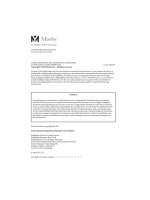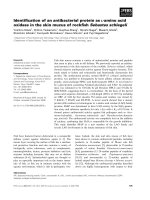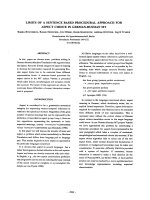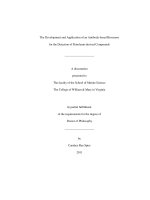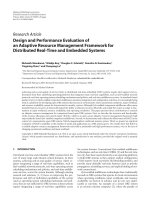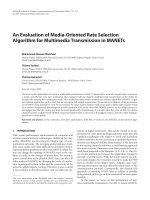Adherence to and efficacy of an evidence based management algorithm for acute asthma in the emergency department
Bạn đang xem bản rút gọn của tài liệu. Xem và tải ngay bản đầy đủ của tài liệu tại đây (395.42 KB, 47 trang )
ADHERENCE TO AND EFFICACY OF AN EVIDENCE-
BASED MANAGEMENT ALGORITHM FOR ACUTE ASTHMA IN THE
EMERGENCY DEPARTMENT
AIZHEN JIN
NATIONAL UNIVERSITY OF SINGAPORE
2003
ADHERENCE TO AND EFFICACY OF AN EVIDENCE-
BASED MANAGEMENT ALGORITHM FOR ACUTE ASTHMA IN THE
EMERGENCY DEPARTMENT
AIZHEN JIN
(MBBS, Shanghai Second Medical University, China)
A THESIS SUBMITTED
FOR THE DEGREE OF MASTER OF SCIENCE
DEPARTMENT OF MEDICINE
NATIONAL UNIVERSITY OF SINGAPORE
2003
i
ACKNOWLEDGEMENTS
With special thanks:
To Prof. Lim Tow Keang and consultant Dr Malcolm, for their professional assistance as
well as constant support that enabled me to both learn and write what is found herein.
To the staffs participating in this study, for their contribution, especially to:
Louis, Department of Medical Affairs, National University Hospital
Norlin, Department of Emergency Medicine, National University Hospital
ii
TABLE OF CONTENTS
ACKNOWLEDGEMENTS i
TABLE OF CONTENTS ii
LIST OF TABLES AND FIGURES iv
Summary of the Thesis v
Chapter 1 Background 1
1.1 Current views on asthma 1
1.2 Summary of guidelines 4
1.3 Use of guidelines in routine practice 8
1.4 Specific aims 11
Chapter 2 Methodology 13
2.1 Study setting and design 13
2.2 Description of intervention program 13
2.3 Evidence for specific recommendations 15
2.4 Selection of patients 19
2.5 Data collection procedures 19
2.6 Statistical methods 20
Chapter 3 Results 21
iii
3.1 Description of study patients 21
3.2 Tables and figures 22
Chapter 4 Discussion 25
4.1 Summary of findings 25
4.2 Comparison with previous studies 25
4.3 Length of stay in the wards 26
4.4 Weaknesses of the study 26
4.5 Secondary results and their implications 30
4.6 Conclusions 33
References 35
iv
LIST OF TABLES AND FIGURES
Tables:
Table 1 Characteristics of patients 22
Table 2 Corticosteroid dose 22
Table 3 Outcome & treatment when patients were admitted 23
Table 4 Comparison of asthma treatment in 2000 versus 2001 23
Table 5 Clinical severity 26
Table 6 Triage classification in ED 28
Table 7 Triage classification, investigations and admission rate 32
Table 8 Comparison of ED relapse rates and repeat visits in 2000 versus 2001 33
Figures:
Figure 1 Outcome & treatment 24
Figure 2 Hospitalization between gender and age group 31
v
Summary of the Thesis
Objectives: To evaluate the adherence to and the outcome of an evidence-based treatment
algorithm for asthma in an emergency department (ED). Design: A non-randomized,
controlled trial. Subjects were adults aged > 14 years with a diagnosis of acute asthma
exacerbation. We compared treatment and outcome before (n= 330, 2000) and after
(n=344, 2001) the introduction of a simple but evidence based treatment algorithm. The
algorithm included: 1) a combination of nebulized salbutamol and ipratropium as first line
treatment; 2) intravenous hydrocortisone and magnesium sulfate with repeat nebulizations
as second line treatment and 3) oral prednisolone on admission to ED & upon discharge.
Results: The use of oral prednisolone at ED admission increased from 42% to 65%
(p<0.001), combination of salbutamol and ipratropium bromide in 1st line treatment
increased from 55% to 94% (p<0.001), oral prednisolone on ED discharge increased from
72% to 90 %( p<0.001), and an increase in intravenous hydrocortisone when admitted
from 52% to 69% (p=0.009). The admission rates (38% Vs 35%) and mean of length of
stay (LOS) in hospital (5.21 days Vs 4.49 days) were not significantly reduced.
Conclusion: We found that introduction of a simple treatment algorithm in the ED resulted
in (1) a significantly improved compliance with evidence based treatment but (2) no
significant reductions in admission rates or LOS.
1
Chapter 1 Background
1.1 Current views on asthma
1.1.1 Definition
Asthma is not caused by a single factor, but by many cells and cellular elements playing a
role in it, in particular, mast cells, eosinophils, T Lymphocytes, macrophages, neutrophils,
and epithelial cells. As the mechanism of asthma has not been completely uncovered, the
definition of this disease is not unified. Here, we introduce the one from the expert panel
report 2, published by National Heart, Lung, and Blood Institute of the National Institutes
of Health from the USA (EXPERT PANEL REPORT 2). Asthma is a chronic
inflammatory disorder of the airways in which many cells and cellular elements play a
role, in particular, mast cells, eosinophils, T lymphocytes, macrophages, neutrophils, and
epithelial cells. In susceptible individuals, this inflammation causes recurrent episodes of
wheezing, breathlessness, chest tightness, and coughing, particularly at night or in the
early morning. These episodes are usually associated with widespread but variable airflow
obstruction that is often reversible either spontaneously or with treatment. The
inflammation also causes an associated increase in the existing bronchial hyper
responsiveness to a variety of stimuli.
1.1.2 Classification
Asthma can be classified into two categories: atopic and non-atopic. The classification is
based on whether specific IgE antibodies to environmental allergens are identified.
2
Asthma is a chronic relapsing and remitting disorder involving episodic reversible airway
obstruction due to bronchospasms, increased mucus secretion and mucosal cell edema.
This makes breathing more difficult and may result in respiratory failure. Asthma may
occur due to an allergy (atopic/extrinsic) or because of other factors (non-atopic/intrinsic).
Both causes are equally common. Asthma attacks vary in duration, intensity and
frequency. Attacks may be mild to life threatening, occur suddenly or with premonitory
symptoms, and may occur at any time, even in sleep. Symptoms of airway obstruction can
persist between acute episodes.
If allergic, the best treatment to control symptoms and decrease relapse, if possible, is
prevention by elimination of the causative agent from the person's environment.
1.1.3 Risk and trigger factors
Although we may not know the real causative agents for many patients with asthma, many
risk factors are found, which increase the probability of asthma development,
increase tendency to asthma attacks by inducing airway inflammation and /or acute
bronchoconstriction. Accordingly, patients are advised to avoid exposure to some factors,
such as smoking, air pollution, aspirin, pollens and molds.
Common triggers of asthma attacks include inhaled irritants, inhaled allergens, and viral
infections of the respiratory tract. Most viral infections that could be associated with
asthma attacks are difficult to document by commonly available means, so the diagnosis is
often presumptive, made on the basis of history and physical examination findings.
3
Airway inflammation may be induced by viruses, which produce a variety of
inflammatory mediators both directly and indirectly. The mediators cause
bronchoconstriction and airway edema.
1.1.4 Further understanding of the pathogenesis
As mentioned before, asthma is not a single disease entity but rather a syndrome with a
multitude of presentations and, most likely, a multitude of causes. Traditionally, asthma
has been regarded as a manifestation of an underlying abnormality of airway smooth
muscle and its neural control systems. However, more recent and current evidence
suggests that in many patients, asthma is an inflammatory disease of the airways.
Pathologic evidence shows that many inflammatory cells and mediators take part in it, for
example, eosinophils, lymphocytes, mast cells (Rowe, 2001). Each cell has an important
contribution and a specific relation to the development of airway inflammation.
Consequently, these cells have become an important target of treatment in the clinical
management of asthma. Understanding how these cells participate in allergic
inflammatory events and how their function can be regulated by therapeutics has provided
insights into asthma pathogenesis and mechanisms of drug action.
1.1.5 Emphasis on anti-inflammation in asthma treatment
Since the definition of inflammation has been proven by biopsies, treatment by anti-
inflammatory drug has been emphasized recently. Studies have shown that improvement
in asthma control achieved by inhaled corticosteroids is associated with improvement in
markers of airway inflammation. These observations indicate that a strong link may exist
4
between features of airway inflammation, bronchial hyper responsiveness, and asthma
symptoms and severity. Corticosteroids affect inflammatory cells through several
mechanisms described below: corticosteroids decrease airway mast cell numbers, and
through this diminish the immediate response to antigen (Barnes,1992); corticosteroids
induce eosinophil apoptosis and in this way it can not release inflammatory mediators
(Goldie,1995); corticosteroids decrease expression and generation of proinflammatory
cytokines (Horwitz,1995), which are generated principally by the T-lymphocyte.
1.2 Summary of guidelines
1.2.1 Guidelines arise in need
In recent decades there have been striking advances in the clinical treatment of asthma, but
morbidity and mortality for the disease are still high. That is due mainly to under-
detection of disease severity and inappropriate therapy. The National Asthma Education
and Prevention Program (NAEPP) comprised of the National Heart, Lung, and Blood
Institute (NHLBI) of the National Institutes of Health (NIH) in the USA initially
published guidelines for the diagnosis and management of asthma in 1991.The guidelines
were based on expert opinion and experience. The purpose of the guidelines was to
provide assistance to clinicians in the diagnosis and treatment of asthma when they
encounter different conditions, to help public health officials, and program planners take
action to control asthma and reduce its personal, social, and economic burdens.
5
1.2.2 Concept of containment at Emergency Departments
Meanwhile, management for acute exacerbation at Emergency Departments (ED) is a
crucial opportunity to minimize these burdens. Because with appropriate treatment at ED,
there are three ways to decrease cost: 1) first it can lessen cost at ED, only using drugs in
need, no more unnecessary ones (Suh, 2001); 2) with appropriate methods of assessment
and intensive use of therapy, excess hospitalization can be avoided (Suh, 2001; Akerman,
1999); 3) giving patients a good action plan and follow-up schedule can decrease asthma
relapse and repeat attendance to ED (Bolton, 1991; ED Manag, 2001);
1.2.3 Guidelines in USA
With understanding of the importance of management in the emergency room, numerous
clinical guidelines on acute exacerbation of asthma have been disseminated. In November
1997, the National Asthma Education and Prevention Program (NAEPP) released the final
version of its comprehensive second Expert Panel Report. This is revision of the one
published in 1991. In 1995 the NAEPP convened a second expert panel to update the
guidelines to reflect important scientific and clinical advances, through critical review of
evidence based literature.
The panel’s recommendations for acute asthma care stressed the use of aggressive inhaled
ß2-agonist therapy, early systemic corticosteroid administration, anticholinergics as add-
on drugs to ß2-agonist in those with severe attack, and oral systemic corticosteroids for 3
to 10 days after discharge (Wiliam, 1998).
6
1.2.4 Guidelines in Canada
In Canada, guidelines for the emergency management of asthma were set up by members
of the Canadian Association of Emergency Physicians (CAEP) and the Canadian Thoracic
Society (Guidelines for Canadian Clinical Practice Guidelines). Recommendations are
similar to the ones in the United States: Beta2-agonists are the first-line therapy for the
management of acute asthma in the emergency department; anticholinergic therapy should
be added to ß2-agonist in severe and life-threatening cases and may be considered in cases
of mild to moderate asthma; all patients should be considered candidates for systemic
corticosteroid therapy at discharge. The different point in the Canadian guidelines is that
adrenaline is recommended as an alternative to conventional therapy in unresponsive life-
threatening cases (Evans, 1993).
1.2.5 Common features in guidelines
There are other guidelines generated by some organizations, such as British asthma
guidelines coordinating committee, Thoracic Society of Australia and New Zealand, and
the Singapore Ministry of Health in 2002. Though some specific steps are different among
these guidelines, the outline of the main points is the same, containing four sections:
Measures of assessment and monitoring, Control of factors contributing to asthma
severity, Pharmacologic therapy, and Education for a partnership in asthma care.
Making the correct diagnosis of asthma is extremely important. Clinical judgment is
required because signs and symptoms vary widely from patient to patient as well as within
7
each patient over time. During therapy, periodic assessment is also required, to establish
whether the goals of asthma therapy have been achieved.
Exposure of sensitive patients to inhalant allergens has been shown to increase airway
inflammation, airway hyper responsiveness, asthma symptoms, need for medication, and
death due to asthma (Vervloet 1991; Kuehr, 1995; Leung, 2002). Substantially reducing
exposures significantly reduces these outcomes.
Observations into the basic mechanisms of asthma have had a tremendous influence on
therapy. Because inflammation is considered an early and persistent component of asthma,
therapy for persistent asthma must be directed toward long-term suppression of the
inflammation. Inhaled corticosteroids are the preferred first-hand medication for
suppression of asthmatic inflammation.
Education remains the cornerstone of asthma management and should be carried out by
health care providers delivering asthma care. Education should start at the time of asthma
diagnosis and should be integrated into every step of clinical asthma care. Asthma self-
management education should be tailored to the needs of each patient, maintaining
sensitivity to cultural beliefs and practices.
2.2.6 Evaluation of clinical practice guidelines
Although many asthma practical guidelines have been published in the past decade, the
morbidity and mortality for the disease are still high. In 1995, there were an estimated 1.9
million
ED visits for asthma in the United States. Hence, some programs were carried out
to help bridge the gap between practice guidelines and the reality of current asthma
8
management. Despite advances in drug treatment, outcomes of patients with asthma
remain largely unsatisfactory. Low rates of patient compliance to the prescribed treatment
regimen, inadequate physician-patient communication, and inconsistent implementation of
evidence-based treatment guidelines are the most important causes for the poor outcomes.
Physician and patient adherence to the guidelines is an important factor in the control of
asthma. Recently in several articles, researchers have suggested that the under utilization
of the asthma guidelines may in part be related to a lack of understanding (Courtney,
2000; Wan, 2002).
1.3 Use of guidelines in routine practice
1.3.1 Chicago-area survey
A cross-sectional, self-administered survey of ED asthma care was conducted in 1996 to
1997. Sixty-four EDs took part in the study, with a response rate of 71.9%. Systemic
steroids (either IV or po)
were estimated to be given to 73.2 ± 3.9% of patients during
their
ED visits. Systemic steroids were prescribed for 55.9
± 3.5% of patients at time of
discharge. Only 57.0 ±
5.4% of patients were estimated to have received any type of
written asthma educational material (Michael, 1999).
The medical directors reported that many of the Chicago-area EDs provided asthma care
that was
consistent with key aspects of national guidelines. However,
in certain critical
areas of care, the EDs demonstrated a high degree
of variation. In view of this, we are
unable to declare that guideline compliance was poor in the Chicago area, because this
study has several limitations. First, the study was based
on self-reported perceptions of the
9
medical directors of the
EDs. Some physicians liked the way questionnaire was asked,
while others did not, therefore certain bias might have existed between respondents and
non-respondents; Secondly, the responses were not verified by direct observation or
chart
audit, so accuracy of recall was doubtful.
1.3.2 Canadian survey
From July 1, 1997 to November 18, 1997 a retrospective chart collection and review was
conducted in Canada, to compare the results with accepted management guidelines for the
emergency department treatment of asthma. In contrast to management guidelines, only
59% of patients received treatment in the emergency departments with inhaled or systemic
corticosteroids. Furthermore, specific follow-up plans were infrequently documented in
the emergency department charts (37%) (Reid, 2000). Adherence with published Canadian
guidelines for the emergency department management of acute asthma exacerbations was
suboptimal. Corticosteroid use in the emergency department was significantly less than
recommended.
1.3.4 Hypothesis on poor compliance
Why does poor compliance with guidelines exist universally for so many years after their
introduction? Some surveys show that the reason is partly due to a lack of understanding
of the guidelines. There are too many guidelines, and each one seems as huge as a book.
Working in busy EDs, it is difficultfor medical staff to devote toomuch time to read
lengthy guidelines. So we feel that, simple treatment steps may be easier to teach, learn
and practice.
10
Asthma management evolves with the advance in knowledge of its pathogenesis, and
significant progress has been made. But an update of guidelines takes several years, and
the dissemination after a new version has been published also takes more time.
(Guidelines were issued by the expert panel’s review of the literature, experience and
opinion). Compliance with guidelines is not adequate in many aspects.
1.3.5 Asthma surveillance in Singapore
Ng et al have conducted a series of studies on adult asthma in Singapore that describe the
prevalence, morbidity and mortality and their relationships with environmental and
medical care factors. These studies showed that there was no evidence of a temporal
increase of mortality from 1976 to 1995 for adults and there is considerable morbidity
among asthmatics, corticosteroids are under-used, and patients' knowledge and self-
management skills are poor (Ng,1999; Tan, 2000).
The latest survey on asthma in the primary care was conducted in late 2001. A group of
family physicians were investigated with regards to their asthma management using a
self-administered questionnaire. There was much disparity between the recommendations
by international guidelines on asthma management and current practice in reality. This
was attributed to both patient's and doctor's factors (Tan, 2001). From previous studies, we
can find that similar problems do exist in Singapore, like inappropriate asthma
management and variation in compliance with guidelines.
To reduce the inappropriate management of asthma, the Singapore Ministry of Health
(MOH) published clinical practice guidelines management of asthma in January, 2002,
11
to work towards the goal of reducing asthma morbidity and mortality (MOH Clinical
Practice Guidelines 1/2002).
1.4 Specific aims
1.4.1 Asthma mortality and morbidity trends
Asthma is a common chronic inflammatory disease, which affects quality of life in
patients and even threatens many people’s lives. Despite more understanding in the
pathobiology of asthma and advancement in drug therapy over recent years, most well-
conducted studies suggest that the prevalence of asthma has been increasing in children
and young adults for the last several decades by approximately 5% to 6% per year
worldwide. In the United States, asthma affected between 9 and 12 million persons in
1987, 14 million to 15 million persons in 1995 (Evans,1987). Asthmatics have 470,000
hospitalizations annually. More than 5,000 people die of asthma annually. In Singapore, it
is estimated that 140,000 individuals have current asthma and more than 100 individuals
die of this disease annually (Chew, 1999).
1.4.2 Economic burden
These increases have laid the economic burden to the whole society. The cost of illness
related to asthma in 1990 in the United States was estimated to be $6.2 billion. Inpatient
hospital services represented the largest single direct medical expenditure for this chronic
condition, approaching $1.6 billion. Forty-three percentage of its economic impact was
associated with emergency room use, hospitalization, and death. (Weiss, 1992) In Canada,
the total cost of asthma was estimated to be between $504 million and $648 million. The
12
single largest component of direct costs was the cost of drugs ($124 million) (Krahn,
1996). Acute asthma (emergency department visits and hospitalization) accounted for
approximately 25% of the total cost associated with asthma care (Bloch, 1995). In
Singapore, the total cost of asthma was estimated to be US$33.93 million per annum.
Inpatient hospitalization accounted for the largest proportion of direct medical expenditure,
approximately US$8.55 million (Chew, 1999).
13
Chapter 2 Methodology
2.1 Study setting and design
In 2001, we conducted a Hospital-based retrospective chart review with the ED electronic
records and medical treatment cards of all adult patients who had an ED ID code of
asthma (493.9).
The objective of this study was to evaluate the adherence to and efficacy of a management
algorithm for acute asthma in the ED, with focus on evidence-based treatment steps rather
than documentation and patient classification.
The study was performed at National University Hospital, Singapore, a large community-
based teaching hospital that provides tedious health care. Research targets were patients
who were admitted to ED with a diagnosis of asthma.
This is a retrospectively controlled study of all adult patients admitted for the treatment of
acute asthma in the same ED over two epochs (February to May inclusive) in consecutive
years 2000 and 2001. We compared the treatment intensity and clinical outcomes of
patients managed in the usual manner before our intervention and following the
intervention program which was instituted in January 2001.
2.2 Description of intervention program
An evidence-based clinical algorithm which was easily understood and acceptable to
doctors was developed. Both emergency and respiratory medicine specialists critically
14
reviewed a total of 169 articles, out of which 8 were Meta analyses on efficacy of
corticosteroids, ipratropium bromide, magnesium sulfate and aminophylline in acute
asthma. These articles were searched out in the literature for clinical evidence on the
management of acute asthma by using MEDLINE (PUBMED) and COCHRANE
electronic databases using the key words “acute asthma” and “randomized” and/or “meta
analysis” dated to December 2000. Recommendations were introduced after review of the
clinical evidence in the local context, with the following features:
1. Simple treatment algorithm rather than a complex clinical pathway
2. Emphasizing evidence-based treatment steps rather than precisely documenting
disease severity and pulmonary function. Based on a study which aimed to assess the
efficacy of a PEFR guided protocol in treating ED asthma.
Data showed that in the
management of acute asthma in the ED, a PEFR guided protocol neither improved
overall PEFR response to treatment nor reduced admission rates when compared with
current management as it is practiced in Singapore (Abisheganaden, 1998).
3. Enhancing second-line therapy to avoid inappropriate hospital admissions, patient
disposition based upon symptoms and physical signs rather than pulmonary function
testing, and
4. Initiating short and long-term preventive care at the ED. Short term aims to gain
prompt control of inadequately controlled persistent asthma or severe acute
exacerbations. Long term aims to reduce frequency and severity of asthma
exacerbations.
15
2.3 Evidence for specific recommendations
2.3.1 Corticosteroid and ipratropium bromide in first line treatment
The recommendations are based on clinical evidence of a high quality. Corticosteroids are
the most effective drugs in the treatment of asthma. They cause marked improvement in
airway inflammation and lung function. Early use of corticosteroids at an ED significantly
reduced the need for hospital admission in patients with acute asthma, and a short course
of corticosteroids for follow-up significantly reduces the number of relapses to additional
care (Rowe, 2002; Plotnick, 1998). Ipratropium bromide may relieve cholinergic
bronchomotor tone and decrease mucosal edema and secretions (Aaron, 2001). The
addition of ipratropium to beta2-agonists improves lung function and decreases
hospitalizations without risk of adverse effects (Stoodley, 1999).
2.3.2 Magnesium sulfate and adrenaline in second line treatment
We noted that not all treatment options in the algorithm are strictly evidence-based. For
example, there was no conclusive evidence for magnesium or adrenaline as second or
third-line drugs in status asthmatics. They were included in the algorithm because we felt
that, despite the lack of agreement on their application, a rapidly escalating intensity in
bronchodilator treatment and thus a broad range of treatment options should be executed.
Some studies already have been conducted to determine whether magnesium sulfate
(MgSO4) has a clinical effect in asthma and results have been conflicting, either in
positive or in negative way. In Gustavo Rodrigo’s study, a meta-analysis of randomized
trials, pooled results revealed that MgSo4 did not decrease significantly admission rates
16
(Rodrigo, 2000); therefore, the addition of MgSo4 to ED patients with moderate to severe
asthmatic exacerbations does not alter treatment outcomes. Nevertheless, the number and
size of studies being pooled remains small, so further definitive controlled studies are
needed to clarify its efficacy.
In research to demonstrate the impact of MgSo4 on expiratory flow in acute asthma
exacerbations, Brian et al concluded that use of IV magnesium sulfate in addition to
standard therapy does not provide clinically meaningful improvement of objective
measures of expiratory flow in patients with moderate to severe asthma (Tiffany, 1993).
But there is also evidence showing that intravenous MgSo4 decreased admission rate and
improved FEV1 in patients with acute severe asthma (Bloch,1995) and it appears to be
safe (Rowe,2000). A cellular mechanism for this bronchodilation effect has been proposed
that it may involve smooth muscle relaxation via calcium antagonism (McLean, 1994).
Mgso4 may also have a beneficial anti-inflammatory effect through affecting
polymorphonuclear neutrophils by interfering with extracellular Ca2+ influx (Cairns,
1996).
Adrenaline is recommended as an alternative to conventional therapy in unresponsive life-
threatening cases in Canada (Beveridge, 1996).
2.3.3 The key interventions in the asthma clinical algorithm
1) A combination of nebulized salbutamol and ipratropium as first line treatment;
2) Intravenous hydrocortisone and magnesium sulfate with repeat nebulizations in second
line treatment
3) Early administration of a systemic corticosteroid
17
4) A course of oral prednisolone for all patients discharged from the ED
5) Fast track referral to a specialist clinic for all patients discharged from the ED
The management of Adult Acute Asthma is based on clinical evidence, as shown in the
following flow chart (Thomas, 1995; Brenner, 1983; McFadden, 1989; Rodrigo, 1993).
18
Patient with asthm a
•Cough
•SOB
•wheeze
Symptoms
of life-threatening
asthma present?
• Silent chest
•Cyanosis
• Feeble respiratory effort
• Exhaustion, confusion or obtundation
• PEFR<35% of predicted
YES (present)
Drug Therapy
1. Salbutam ol (ventolin) nebulised therapy: 1ml (5mg) salbutamol with 2m ls (0.5 m g) ipratropium
brom ide & 2mls N/S to make up to 5mls. Repeat twice
2. Oral prednisolone 0.5 - 1mg/kg (max 60mg)
NO
(not present)
Supportive Measures
1. Managed in P1 area with supplemental O
2
, high flow.
2. Monitoring: ECG, pulse oximetry, vital signs q5-10m ins.
3. IV access 500mls crystalloid over 3-4 hours
4. Prepared for rapid sequence intubation: have paralysing and sedating drugs readily available.
5. Use serial ABG’s to detect triad of progressive hypoxaemia, hypercapnia and acidosis.
6. Indications for intubation: persistent hypercarbia, severe hypoxia w ith PaO
2
<60.
7. CXR: patients not responding to initial therapy.
Non-responders/partial response
1. PEFR <50% predicted within 60mins:
repeat neb 2 - 3 times utilising
salbutam ol 5mg or 7.5mg with 0.5mg
ipratropium, 1.5mls N/S to 5m ls.
2. Corticosteroids: Hydrcortisone 400 -
500mg I/V.
3. I/V Mg SO
4
1 - 2gm slow bolus (20
mins)
4. Adrenaline: (use with caution if at all
in elderly, IHD or se vere hypertension)
0.3 - 0.5mls 1:1000 solutions S/C q 20
mins;
OR Terbutaline: (more β2 selective than
adrenaline) 0.25mls S/C 20-30 mins
prn.
Consider admission
1. Patient unable to attain PEFR
≥ 50% despite therapy and
observation 1 - 2 hours.
2. Previous intubation / ICU
admission
3. Xray evidence of
pneumothorax
or pneumonia
Improvement
All other asthmatics/COLD patients
1. Check patient and PEFR: (optional
and must also measure height)
baseline and after 2 neb doses.
2. Reassessment: if PEFR ≥ 50% and
subjective im provem ent consider
discharge with early follow up
within 48 hours (Respiratory
Medicine Clinic).
3. All patients at discharge should
receive oral prednisolone 0.5 -
1mg/kg/day (40mg m ax no tail)
for 7 - 10 days and follow up.
4. Additional: inhaled steroids
(pulmicort turbohaler 200mcg bd).
ASTHMA CLINICAL ALGORITHM
Re-Evaluate
